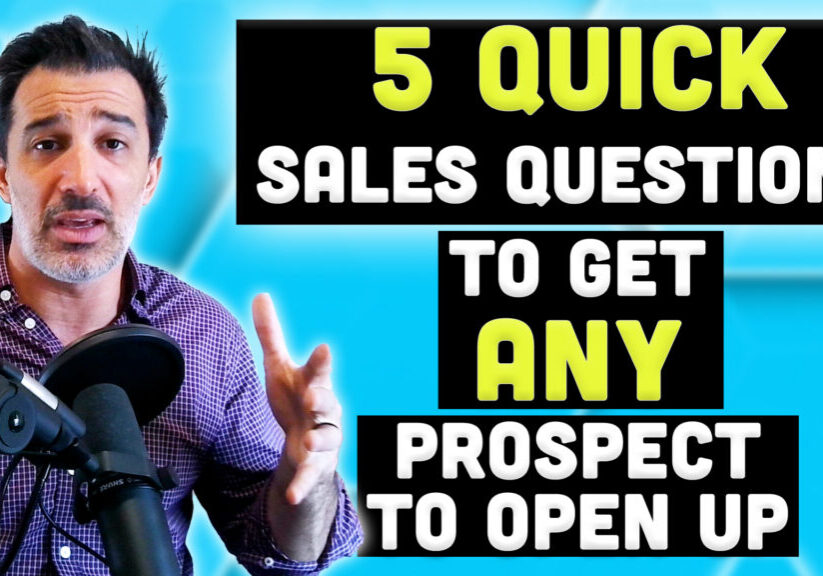One of the biggest challenges salespeople face today is that they simply don’t have enough appointments in their calendar.
Having a calendar that’s chock-full of appointments is the first key to being successful in sales. Getting that initial appointment set is like the gold standard of your first step to success in sales.
But of course, in order to really be successful, those appointments should be with prospects you actually want to do business with—your ideal prospects.
In this video, I’m going to show you the 7 key steps to setting an appointment in sales with any customer. Check it out:

1. Only set appointments with your ideal prospects.

The idea of being able to set an appointment in sales with any customer sounds good in theory. But this concept is actually flawed, right? Because we don’t want to be setting appointments with just any customers. We want to be setting them with the right prospects—the people who are most likely to be a great fit for what we sell.
I see a lot of salespeople who have full calendars with tons of appointments, but they’re just not with the right people. To avoid this when setting an appointment, it’s important to make sure we’re targeting our ideal prospects. This requires that we take a step back and think: “Who do I really want to be having conversations with?” Ask yourself: If you could get in front of any type of person, who would that be? What would their title be? What traits would they have? What would their geography be? What would their concerns be? What challenges do they have?
Getting clear about your ideal prospect is so important. At the same time, it’s imperative to be clear about who your ideal prospect is not. Who are the people or organizations that are absolutely not going to be a fit for what you do? Take them off the list ahead of time so you can basically pre-disqualify them before you’re even on the phone. This will save you from wasting time and effort on people who are never going to be a fit. Instead, only focus on setting an appointment with someone who is actually a good fit—your ideal prospect.
2. Create an outreach machine.

We’re fortunate to live in a time when there are so many incredible tools that allow us to automate the sales outreach process.
Of course, when it comes to setting an appointment in sales, human interaction is sometimes still needed. But with the right tools, we can systematize and automate everything else.
These systems enable us to hold the whole prospecting campaign together with email—and then we’re given task reminders to make calls at the right times, which can also be done with power dialers. We can also use social media, texting, and any other platforms for outreach that work well with our prospects.
Whether it’s fully automated or run completely by you, you want to make sure that you create an outreach machine. This will enable you to dial-in the entire process, including all the steps that you take every prospect through to warm up the relationship. So that way, by the time you get them on the phone, they already have an idea of who you are and what kind of value you can offer them.
3. Focus on what your prospect actually cares about.

This might sound obvious, but you’d be surprised at how many salespeople think about their copy and scripting from the perspective of the organization they represent. They start from a place of “What do I want to sell and how do I get them to buy it?” as opposed to thinking, “What are the challenges that my prospect has? What do they care about? What are their goals? What are the objectives they’re looking to accomplish?”
If you really want to master setting an appointment with your ideal prospect, then you must craft your outreach strategy, your copy, and your scripting based on what your ideal prospect actually cares about. Speak your prospect’s language.
It’s not your prospect’s job to figure out how they can fit your offering into their world. It’s your job to figure out how your offering is going to improve their world. That’s on you. So all of your outreach needs to be focused on them.
4. Have a kick-ass call to action.

I’m really passionate about this step to setting an appointment with ideal prospects. When most salespeople do outreach, they lead with some version of, “Hey, I’d love to get on a phone call with you to learn more about your business, so that way we can determine whether we’re a fit.” And I just think to myself, What prospect on the planet would consider that an attractive proposition? Like they want to sit around and teach some random salesperson about their business?
When we’re reaching out to ideal prospects, we need to come in with a call to action that’s kick-ass. There’s no better way to put it. We need something enticing, something that sounds undeniably useful to the prospect. The call to action can’t be getting on a phone call with you. No matter how great you are, nobody wants to talk to a salesperson just for the sake of chatting with them. While your friends and family may be really excited to get on a phone call with you, I can promise you that your prospects are not.
So we need a kick-ass call to action in our emails, in our phone outreach, in our social outreach—and whatever it is must give prospects a real reason to get on the phone with us and engage.
5. Make a recommendation.

Once you’ve got an ideal prospect on the phone and the conversation has gone well so far, it’s time for setting an appointment. At this point, most salespeople say something old-school, such as: “Hey, turns out that I’ll be in your area on Tuesday or Thursday next week—what’s better for you?” They try sneaky, roundabout ways to try to set an appointment. But they’re not fooling anyone.
The most effective way to set an appointment is to make a recommendation once the conversation has been going well. This recommendation must be made in a strong, firm, confident way. It might sound something like: “Can I make a recommendation?” (The prospect will say, “Sure.”) Then you say: “Ok, great. Why don’t we schedule an appointment where we can go more deeply into this conversation, and I can share with you some best practices that we’re seeing…Does that make sense?”
Be sure to use a strong, firm tone here. The prospect will be much more inclined to say yes if it feels like you’re confidently leading them to take a reasonable next step.
6. Be firm.

I find that a lot of salespeople start to get uncomfortable when they’re trying to turn a conversation into an appointment. They tend to adopt a really soft approach, using words like maybe and kind of. But this is the opposite of what you need to do in order to master setting an appointment with ideal prospects. Instead, you need to be firm when scheduling the appointment. This is where the prospect needs leadership. Lead them through the process.
I’m not telling you to be pushy or aggressive; just firm. This is why a script is so powerful—the more you can script out your process, the more you can stop worrying about what to say next, and just follow your process without resorting to soft, ineffective language because you’re nervous.
So make a firm recommendation and stick to it. There might be some pushback, and that’s fine. The more firm you are, the higher your chances of actually setting an appointment.
7. Have contingencies.

When we’re on the phone with a stranger who doesn’t know us, they’re almost like a bucking bronco, right? They’re just trying to get us to go away. Even if they feel like we could be good for them or for their organization, there’s still a natural tendency for prospects to want to just end conversations with salespeople. This is why contingencies are so important when it comes to setting an appointment in sales.
There are some really common things that prospects tend to say to salespeople, particularly in cold interactions, that are aimed at ending the interaction. For example: “This actually isn’t a good time,” “Could you try me back in a couple of weeks?” or “I’m busy right now.”
When a prospect says something like this at the start of your conversation, you must have contingencies in place to respond. These contingencies are basically just prepared lines to use as responses to likely objections or pushback.
So if a prospect says, “I don’t really have time right now,” your contingency might be to say: “It sounds like you’re really busy. Would it be okay if I just took 30 seconds to tell you why I called? And if after that it doesn’t make sense, we could just hang up. Does that sound fair?”
Having a contingency like that can help you get to the next 30 seconds of the conversation, and this is key to keeping the interaction going just a while longer. Having these contingencies all in place, scripted out, prepared, and role-played is going to make your outreach so much more effective at setting appointments.
So there you have it. Now you know the 7 keys to setting an appointment in sales with any customer. Which of these steps are you going to implement into your prospecting approach? Be sure to share your thoughts in the comments section below to join the conversation.
More Steps to Setting Appointments with ANY Customer…
Do you ever look at your calendar and see nothing but a blank white page, stretching on and on? It’s like a white cow in a snowstorm. But it doesn’t have to be that way.
The reality is, if your calendar is empty, you’re simply never going to hit your sales goals.
I come across so many salespeople who would blow past their sales goals if they could only get in front of more people on scheduled appointments. Having a systematic approach for setting an appointment is key to success in sales.
That’s why I’ve put together my top tips to teach you how to set an appointment in sales. In this video, I’m going to show you 5 steps to setting an appointment with any customer. Check it out:
8. Know your IPP.
 IPP stands for Ideal Prospect Profile. Before you can master how to set an appointment in sales—and, in fact, before you even start to make dials or send emails at all—you must first be crystal-clear on exactly who you want to be talking to.
IPP stands for Ideal Prospect Profile. Before you can master how to set an appointment in sales—and, in fact, before you even start to make dials or send emails at all—you must first be crystal-clear on exactly who you want to be talking to.
This is absolutely crucial. Think about how much effort it takes to actually get someone to say, “Yeah, I’d like to talk to you.” And then, after all that effort, let’s say that person turns out to be the completely wrong individual for you to talk to. If that happens, it’s because your IPP is incorrect.
When your IPP is off-base, you end up wasting time talking to people who were never going to buy from you in the first place. So, the clearer you are about your IPP, the more effective your outreach will be. And, in turn, the more often you’ll be able to set an appointment.
One of the best ways to tighten up your IPP is to identify who you don’t want to speak to. Who are those candidates you might come across that are likely to not be a fit? Getting very clear on who you don’t want to talk to will ultimately help you clarify exactly the person you want to connect with.
9. Hyper-personalize your message.
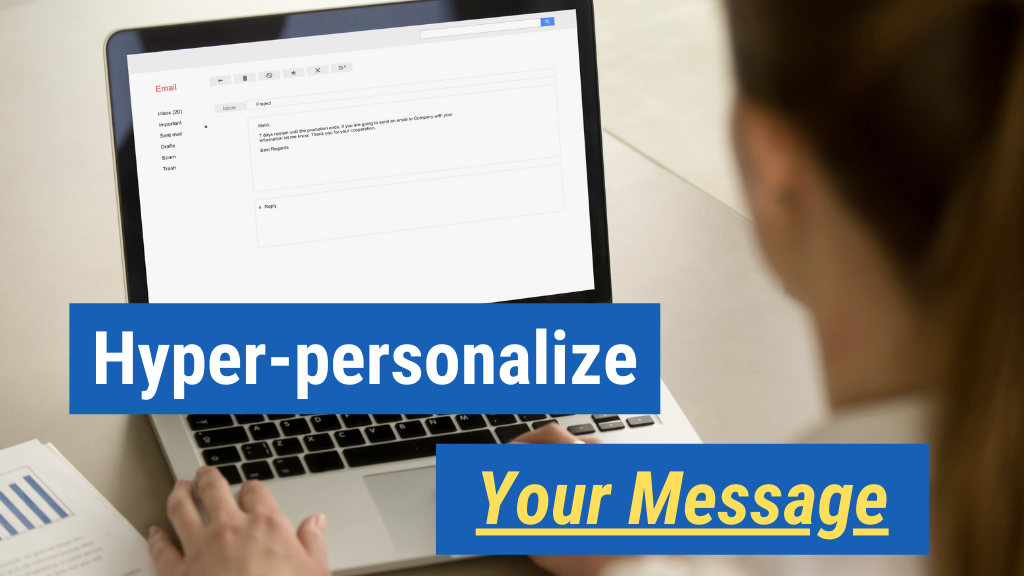 This is modern prospecting in a nutshell. The more personalized your outreach is, the more effective it’s going to be. When it comes to learning how to set an appointment, personalization is key. Personalization is closely tied to your IPP. If you have a well-focused IPP, you can personalize a lot of your messages right off the bat, even while sending out a pretty similar message to each person. That’s because you’re likely sending messages to people in the same industry who are dealing with the same problems. So, the better and clearer your IPP is, the easier and more effective your personalization.
This is modern prospecting in a nutshell. The more personalized your outreach is, the more effective it’s going to be. When it comes to learning how to set an appointment, personalization is key. Personalization is closely tied to your IPP. If you have a well-focused IPP, you can personalize a lot of your messages right off the bat, even while sending out a pretty similar message to each person. That’s because you’re likely sending messages to people in the same industry who are dealing with the same problems. So, the better and clearer your IPP is, the easier and more effective your personalization.
Another way to hyper-personalize your message is to use personalization fields in your outreach. Seek out specific pieces of information with some simple research and use that data to get your prospects to say, “Hey, this person has really done their homework on me.” This is going to get prospects to open up much more—and they’ll be much more likely to actually schedule an appointment with you.
10. Demonstrate very quick insight.
 Setting an appointment in sales depends upon your ability to demonstrate authority and expertise. To do that, you’ve got to quickly bring some insight to the table, because your prospects are busy. They don’t want to get their brains picked or probed by a salesperson who’s trying to “learn about their business” or whatever it is.
Setting an appointment in sales depends upon your ability to demonstrate authority and expertise. To do that, you’ve got to quickly bring some insight to the table, because your prospects are busy. They don’t want to get their brains picked or probed by a salesperson who’s trying to “learn about their business” or whatever it is.
Set yourself apart from other salespeople by bringing some really valuable, quick insight to the prospect, up front. Make sure it’s something that will make your prospects say, “You know what? That makes sense. I’m willing to talk to you.” This isn’t about your offer; it’s not about your pitch, It’s just about demonstrating some very quick insight, right up front.
11. Understand them.
 Once you’ve demonstrated that quick insight, it’s time to flip the switch and get the prospect talking. The goal here is simply for you to understand them. Understanding your prospects is a critical piece of mastering how to set an appointment.
Once you’ve demonstrated that quick insight, it’s time to flip the switch and get the prospect talking. The goal here is simply for you to understand them. Understanding your prospects is a critical piece of mastering how to set an appointment.
You can actively try to understand your prospects by having a specific set of questions you ask to get them to open up. Once you get a prospect on the phone, immediately start trying to understand exactly what’s going on in their world. What are their central concerns? What’s most relevant to them?
The key here is that you’ve already demonstrated quick insight at the beginning of the conversation or in any outreach you’ve done up until that initial conversation. And then you’re turning it back on them to get them to start opening up. The more your prospect feels that you genuinely understand their situation, the more likely they are to want to schedule that appointment and ultimately buy from you.
12. Make a recommendation.
 Once you’ve got someone who’s willing to talk to you, it’s time to make a recommendation. Don’t just go for the close or try setting an appointment right away. Instead, make a recommendation by saying something like, “Would it be okay if I made a recommendation?” They’ll say, “Sure.” Then you say something such as, “Okay, great. How about we schedule a Zoom conversation where I can share some best practices around exactly what we’re seeing other folks in your situation dealing with right now? Would that make some sense?” The prospect will very likely say, “Yeah, sure.” And now you have an opportunity to schedule that appointment.
Once you’ve got someone who’s willing to talk to you, it’s time to make a recommendation. Don’t just go for the close or try setting an appointment right away. Instead, make a recommendation by saying something like, “Would it be okay if I made a recommendation?” They’ll say, “Sure.” Then you say something such as, “Okay, great. How about we schedule a Zoom conversation where I can share some best practices around exactly what we’re seeing other folks in your situation dealing with right now? Would that make some sense?” The prospect will very likely say, “Yeah, sure.” And now you have an opportunity to schedule that appointment.
One of the most important factors of setting an appointment is bringing value to that next step. If prospects think that you’re just scheduling an appointment to try to sell them stuff, they’re going to be pretty guarded and uncomfortable. But once you create some context for why that next step makes sense through your recommendation, they’ll be far more likely to agree to that next step—and actually show up. That’s why making the recommendation is a really important step to ultimately scheduling that meeting.
So there you have it. Now you know 5 steps to setting an appointment with any customer. Which of these tips about how to set an appointment did you find most useful? Be sure to share below in the comment section to get involved in the conversation.
Even More Appointment-Setting Steps…
What’s the most important metric you can track in sales to determine whether you’re going to hit your sales goal?
Most people think it’s sales numbers, but that couldn’t be further from the truth. In all my years of research, I’ve found that the most important metric to track in sales is the number of appointments you’re setting with prospects.
Let me put that another way. The most important metric to track in sales is the number of discovery meetings or appointments you set. Your ability to set the appointment is critical to your success in sales.
Simply put, if you consistently set the appointment with solid prospects, you will hit your sales goal—period.
Of course, what you do and say during those meetings has a tremendous impact on your sales efforts, and whether they are productive and effective. But the most important piece of the puzzle is just setting enough appointments in the first place.
It’s time to stop struggling to convert a conversation with a good prospect into a scheduled appointment. In this video, I’m going to show you the 7 keys to set the appointment with any prospect in sales. Check it out:
13. Don’t set an appointment with just anyone.
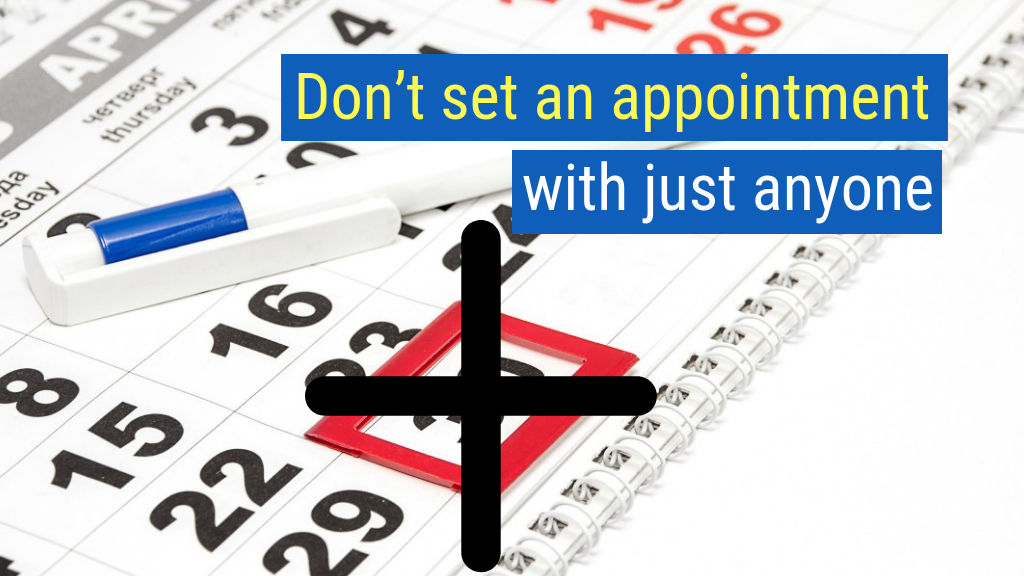
Great salespeople don’t try to set the appointment with just anyone. They only try to set the appointment with the right person.
I was just talking to a customer of mine in my online forum. He said, “I’m having a lot of success setting appointments with marketing people at various companies. But once I meet with them, they say, ‘Oh, well I need to get buy-in from the company owner before we can move forward.’ What could I be doing differently?”
This was my immediate response: “You’re setting the appointment with the wrong person.”
The key is to set the appointment with the right contact, the real decision maker, the person who has access to write a check—or at least has a budget to pay for what you do.
So, the goal isn’t to just set an appointment with anyone who has a pulse. Instead we want to be sure that we set the appointment with people who seem like they will be qualified to have a real conversation and ultimately make an effective decision to move forward or not.
14. Disqualify the rabble during discovery.

This is important. Sometimes, salespeople get so excited when they have a person in front of them who is willing to pick up the phone and talk. But we can’t know if someone is qualified just because they’re willing to get on the phone with us.
That’s why we want to do some partial discovery on the initial phone call to determine whether a prospect is qualified. Ask questions that will help you understand whether the prospect is the right person to do business with.
What types of answers is the prospect giving you? Is the prospect down in the weeds or taking a big-picture view? Does the prospect understand the cost of the challenges at hand? Does the prospect have the right kind of problems for you to solve? If the answers to these questions don’t paint the picture of your ideal prospect and decision maker, then you can know up front that the prospect is not a fit.
One of the key distinctions between top-performing salespeople and everyone else out there is the ability to disqualify the rabble during discovery—and thus spend the majority of their time in front of truly qualified prospects.
The other powerful effect of this is that you’re not going to come off as needy, because you’re not trying to set the appointment with just anyone. The prospect will notice this and think, “Wow, this person feels like a true professional because they’re not just trying to do anything to get into my office.”
15. Be a doctor.
 Your prospects typically meet with salespeople who will do or say anything just to get the sale. This manifests with the salespeople putting lots of pressure of prospects and being salesy in a variety of ways. In order to set the appointment with your ideal prospects, you want to be the complete opposite of this. Give your prospects the opposite of their typical buying experience.
Your prospects typically meet with salespeople who will do or say anything just to get the sale. This manifests with the salespeople putting lots of pressure of prospects and being salesy in a variety of ways. In order to set the appointment with your ideal prospects, you want to be the complete opposite of this. Give your prospects the opposite of their typical buying experience.
The best way to do this is to act not like a salesperson, but like a doctor.
Let me give you an example. Let’s say you go to an orthopedic surgeon because your back hurts. Do you think that doctor will immediately say, “Well, you’re in the right place! We have this incredible new procedure that has all the bells and whistles you’re looking for! We’re going to chip away at the bad stuff, get you back walking within a week, and within six weeks you’re jogging again! So, are you ready to do it? Here is the contract.”
No, of course not.
That’s not how a good doctor behaves—but that is how salespeople often behave. The prospect comes to him, mentions a challenge, and then the salesperson says, “Well, we’ve got the solution for you! We are the best at this and we can do it better, faster, and cheaper than anyone else. So, would you like to do it?” Eek. It’s pretty gross, right?
You almost need to take a mental shower of that. Instead what we want to do is behave like a doctor. Take the time to diagnose the challenges that our prospects bring to us. If a prospect says, “We are having some issues with our marketing,” instead of saying, “Well, we can solve that,” say, “So, tell me a little bit more. Help me understand what’s going on with your marketing right now.” Get them engaged. Be that doctor, and dig more deeply.
16. Understand the upside.
 To successfully set the appointment, the prospect has to feel like there will be value in meeting with you. So, put yourself in the shoes of your prospects. They’ve got a million things going on and the last thing they want to do is spend 45 minutes with a salesperson who is wasting their time.
To successfully set the appointment, the prospect has to feel like there will be value in meeting with you. So, put yourself in the shoes of your prospects. They’ve got a million things going on and the last thing they want to do is spend 45 minutes with a salesperson who is wasting their time.
So, during your initial prospecting calls, you need to help your prospects see the value of potentially working with you. And one of the key ways to do this is to help them understand the upside of solving their problem.
A lot of salespeople get this wrong because they focus on the ROI their prospect will get by working with them. But what’s actually more important is getting the prospect to tell you the upside of fixing their problem. This is understanding the upside.
Here’s an example. I’m talking to a company’s CEO and she says, “Our sales team just isn’t firing on all cylinders.” I ask, “Well, if you were able to get your salespeople firing on all cylinders, what do you think that would mean in additional revenue to the organization?” And the CEO replies, “I think we could easily be doing an additional $5 million in sales.”
Time out. Do you see what just happened there? I asked what seemed like a pretty benign question and I got the prospect to actually start to do her own math, to talk about the value that my solution could potentially bring to the company.
Of course, this doesn’t draw a direct line from my solution to $5 million. But it does get the prospect to think, “If I could solve this problem with this person, it could mean an additional $5 million for my organization in revenue.” That is the upside value of working with me in that particular situation.
You can do this for every single selling situation. Upside doesn’t have to be increased revenues. It could be decreased costs or additional profitability. But every solution is going to have an upside. What you want to do is get your prospect to articulate what the upside is to solving those key challenges.
Once you do that, the obvious value of working with you—or at least of setting that appointment with you—becomes incredibly apparent.
17. “Can I make a recommendation?”
 These five simple words are so powerful when it comes to being able to set the appointment with your ideal prospects. I’m giving you some real secret sauce here. The phrase, “Can I make a recommendation?” is really powerful when it comes time to transition into scheduling the appointment in sales.
These five simple words are so powerful when it comes to being able to set the appointment with your ideal prospects. I’m giving you some real secret sauce here. The phrase, “Can I make a recommendation?” is really powerful when it comes time to transition into scheduling the appointment in sales.
And here’s why. Let’s say you’ve gone through the initial conversation, you’ve gotten them to articulate the upside, and you’ve determined that this is someone that you definitely want to be setting a meeting with. You then need to transition into setting the meeting by starting with this phrase. By asking, “Can I make a recommendation?” you naturally cause the prospect to say, “Of course.” At the same time, this exchange sets you up as the expert who makes recommendations. And now they’re completely open to your suggestion.
Next, you would say something like, “Why don’t we schedule an appointment? We can get together face-to-face for about 45 minutes, and we can dig into some of these issues much more deeply. I could also share some best practices on how we might go about solving those challenges. Does that make sense?” And naturally they’re going to say (assuming you’ve done a good job up until then) yes.
If they don’t say yes, how you would respond? We’ll dive into that in Key #7 to Set the Appointment, so keep reading.
18. Always schedule a clear next step.
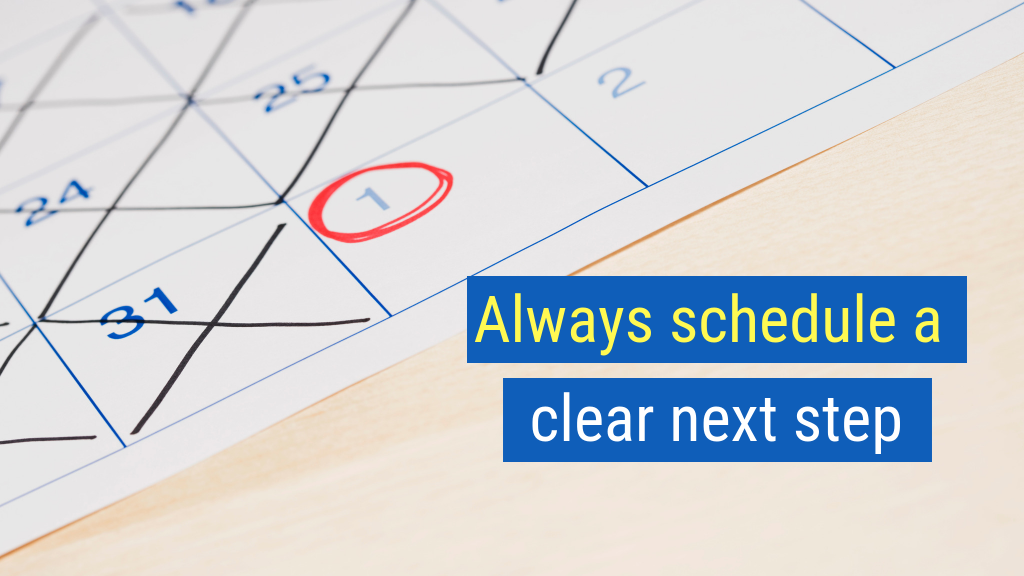 This is so important for sales in general, and it’s critical for actually setting the appointment. I want you to make a commitment to yourself that you are never going to allow any selling situation to end with an unclear outcome.
This is so important for sales in general, and it’s critical for actually setting the appointment. I want you to make a commitment to yourself that you are never going to allow any selling situation to end with an unclear outcome.
Salespeople are doing this all the time. They’re on the phone with a prospect and it kind of ends in a wishy-washy place and the prospect gives them something like, “Hey, why don’t you call back in a month?” And the salesperson says, “Ok, sure.”
Instead, make sure that there is always a clear next step at any point in the sales process—but especially at the beginning. You want there to be a clear scheduled next step where a calendar invite goes out to the prospect—and they accept it. Even if they say, “Could you give me a call back in a month?” say something along the lines of, “I’d be happy to do that. Do you actually have your calendar in front of you so we can schedule something? That way we don’t have all that back-and-forth and miss each other.” If they say no to that then you know you’re in trouble.
But if they say yes, now you’ve at least got something in the books.
19. Have a contingency for when they push back.
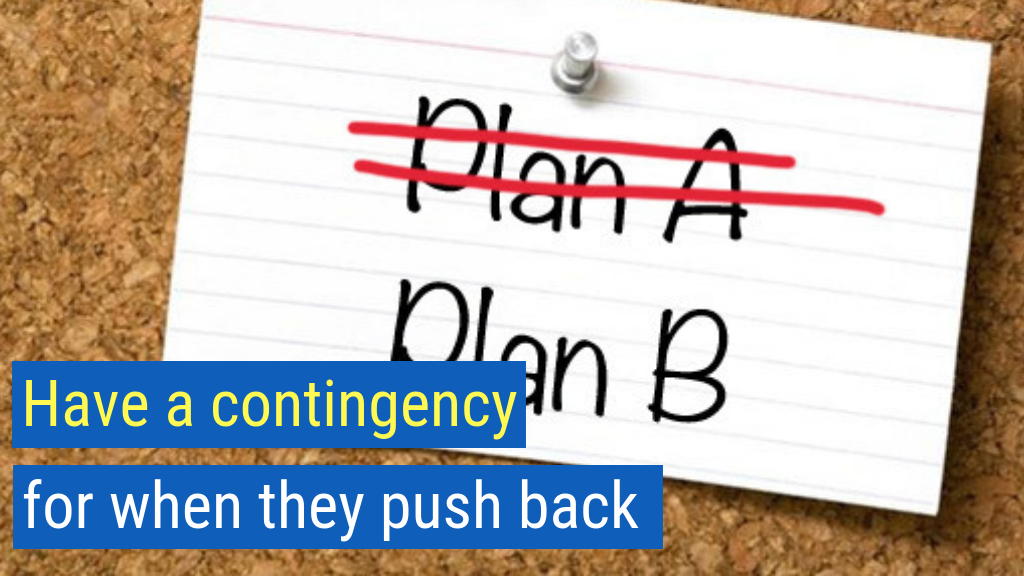 Often we’re in a selling situation and the prospect gets a little bit squirrelly. And they say, “This was a great conversation but the timing just isn’t right. Could you call me back maybe in six months?” And a lot of salespeople go into something that sounds like: “Oh yeah sure, happy to call you back in six months. Would it make sense to call you on a Monday or Thursday?” or whatever weak response they have.
Often we’re in a selling situation and the prospect gets a little bit squirrelly. And they say, “This was a great conversation but the timing just isn’t right. Could you call me back maybe in six months?” And a lot of salespeople go into something that sounds like: “Oh yeah sure, happy to call you back in six months. Would it make sense to call you on a Monday or Thursday?” or whatever weak response they have.
Instead, I want you to have a contingency in place for when they push back on setting the appointment. Let’s say the prospect says, “I’m really busy this month. Could we maybe get together next month? Shoot me an email in a month and we can set something up.” Reply with your contingency: “I really appreciate your saying this, but having done this for a long time, I know that usually people tell me this because it’s a nice way of saying they’re not really interested in ever getting together. Is that what you see happening here?”
Now, that takes guts.
But if you do that, you’re going to find that the prospect will say one of two things. Either, “Yes, this just doesn’t make sense for me,” or “No, I really am busy and would like to get together—this month just isn’t good for me.” In that case, you can reply: “That sounds totally reasonable. How about we put something in the calendar for next month so we can just avoid that back-and-forth. We’ll get together then. But at least we’ll have it in the calendar so this doesn’t just fall off the radar. Does that sound OK?”

Either way, you will know right away whether the prospect is actually qualified, and avoid wasting your time chasing down a prospect who doesn’t want to meet with you. If someone’s being wishy-washy with you on the phone about scheduling an appointment, you don’t have much to lose anyway.
So, there you have it. There are the 7 keys to set the appointment with any prospect in sales. Which of these ideas did you find most useful? Be sure to share in the comments section to get involved in the conversation.

Enjoyed this article? Please share away!

Get instant access to our free sales training:
Why Prospects Push Back on Price, Give 'Think-It-Overs,' and Ghost in Sales Until They Meet a Sales Superstar Who Is Following These 7 Simple Keys

About the Author Marc Wayshak
Marc is is the best-selling author of three books on sales and leadership, including the highly acclaimed titles Game Plan Selling, The High-Velocity Sales Organization and his forthcoming book, Sales Conversations, Mastered.
Marc is a contributor to Inc, HubSpot, Fast Company, Entrepreneur Magazine, and Huffington Post Business. He also hosts a popular YouTube channel on sales strategy with over 103,000 subscribers.
Marc helps thousands of people his data-driven, science-based approach to selling that utilizes all the best tools available to sales organizations today.

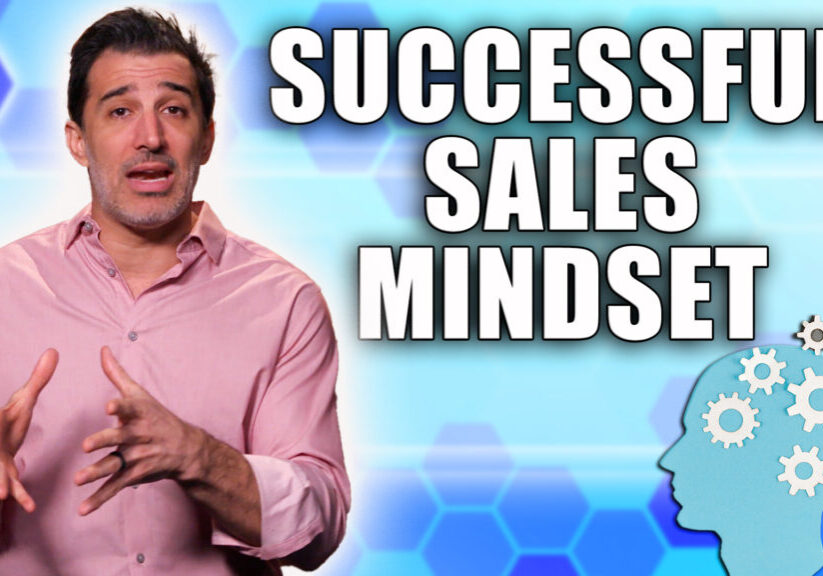
![How-to Sell to Power [C-Suite Sales Must-Knows!] How to Sell to Power [C-Suite Sales Must-Knows!]](https://salesinsightslab.com/wp-content/uploads/bb-plugin/cache/How-to-Sell-to-Power-C-Suite-Sales-Must-Knows-1024x576-landscape-7a52c541b28a7b772ad9e1010d8240be-.jpg)


![The Absolute Best Way to Start a Sales Conversation [WITH ANY PROSPECT] The Absolute Best Way to Start a Sales Conversation [WITH ANY PROSPECT]](https://salesinsightslab.com/wp-content/uploads/bb-plugin/cache/The-Absolute-Best-Way-to-Start-a-Sales-Conversation-WITH-ANY-PROSPECT-1024x576-landscape-be9d9379ab94d9f71b5bfeed42246a84-.jpg)
